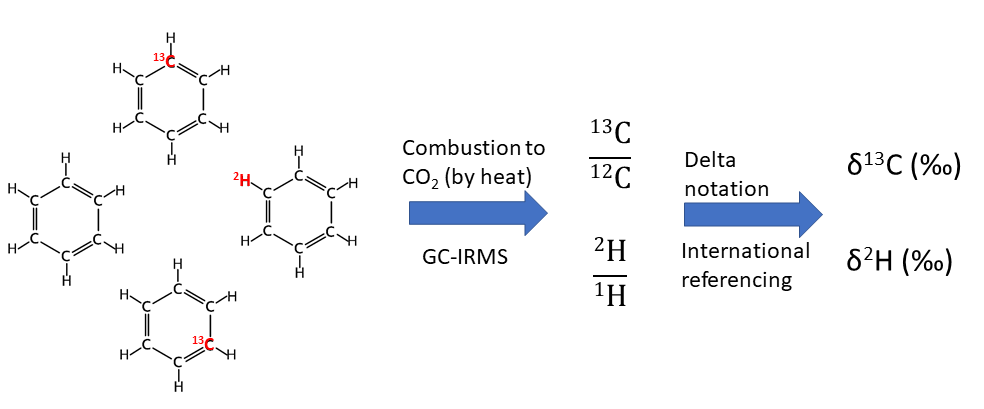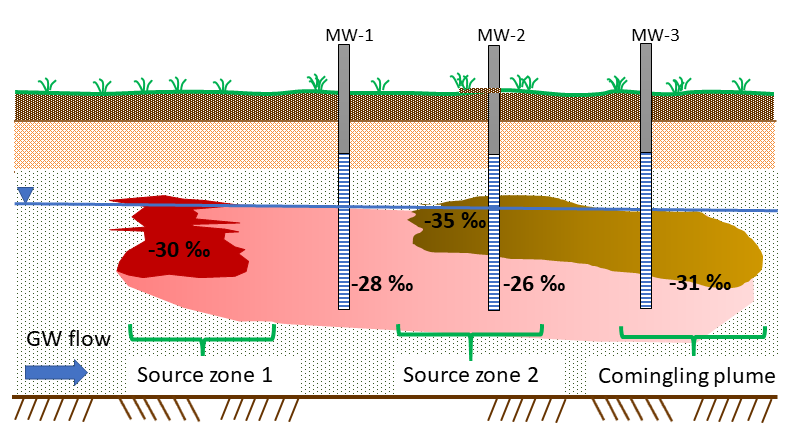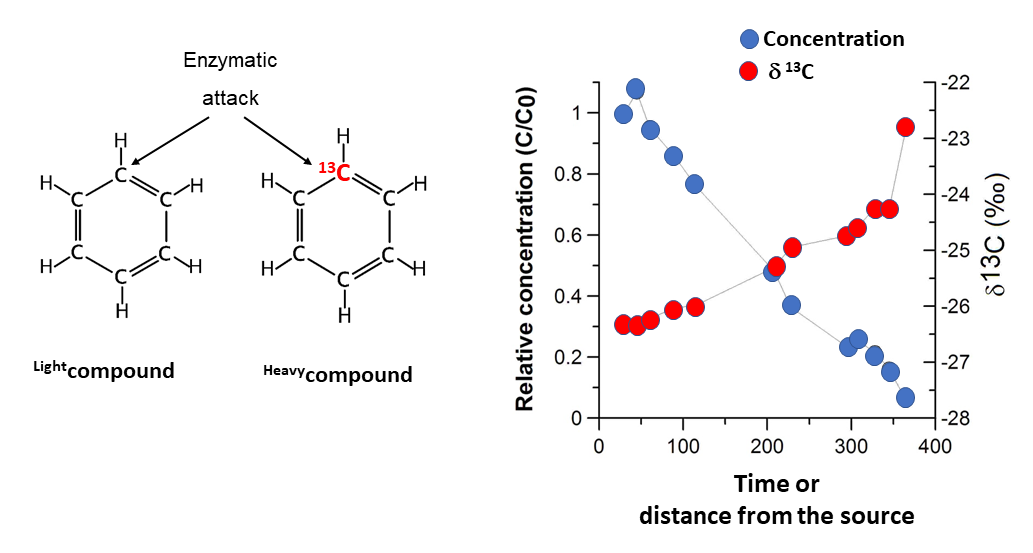Compound Specific Isotope Analysis
What is CSIA?
Compound-specific isotope analysis (CSIA ) refers to the measurement of the isotope ratios (e.g., 13C/12C, 2H/1H, or 37Cl/35Cl) of individual volatile and semi-volatile compounds extracted from in environmental samples. This characterization tool can be used for demonstrating in situ destruction of selected VOC and for firensic investigations to gain information about potential contaminant sources, the extent of degradation, comingling of contaminant plumes, and the origins of some chemicals.
This powerful tool is capable of revealing information that cannot be gained by from evaluation of concentration data. CSIA provides a quantitative means to differentiate reaction pathways for abiotic and biotic degradation. It can provide information biodegradation pathways and may serve as a basis for identification of distinct pollutant sources. CSIA can provide a evidence for monitored natural attenuation of sites contaminated with a wide variety of pollutants.
How does it work?
Many atoms have a heavier counter partner naturally occurring in nature. Since the C, Cl and H atoms pool in nature is composed of light isotopes (12C, 35Cl and 1H) and heavy isotopes (13C, 37Cl and 2H) in different proportions heavy to light, occurrence of one heavy isotope is hence expected within the constitution of some organic molecules. The 13C/12C and 2H/1H isotope ratios for each VOC of interest included in a mixture can be measured, and reported accordingly to an international referencing system. The final ratio is finally multiplied by 1000 to avoid reporting very small fractions, hence making the units in permil. i.e. ‰.
What are the targeted contaminants?
For several mechanistic reasons, CSIA is a tool adapted for small molecular size VOCs such as:
- BTEX
- MTBE
- Chlorinated solvents
With some restrictions, additional VOCs can be addressed within some defined and site-specific objectives:
- Chlorobenzene
- Naphthalene
- ETBE
- 1,4 dioxane
- Alkanes < C8
For which sampling matrix?
- Groundwater: CSIA assessments are commonly carried out for VOCs dissolved in groundwater.
- Gaseous phase: With the recent development of reliable gas-phase sampling devices, CSIA assessments can also be performed for gas-phase VOC (such as soil-gas, atmospheric or indoor air).
- Soil: Application of CSIA on soil cores remains less frequent for the moment, as research studies yet remain scarce.
Why use CSIA?
Field practitioners and contaminant hydrogeologits are taking advantage of this naturally occurring confection default of the atom to gain insight on the origin and fate of targeted organic contaminants.
Origin
The isotopic ratio can be seen as the fingerprint of the contaminant. Because several diverse factors govern the synthesis of petroleum hydrocarbons or the manufacturing of chlorinated solvents, different δ13C, δ37Cl and δ2H signature for the same VOC coming from a different synthesis\manufacturing process will be obtained. A substantial advantage of this non uniformity is that the isotopic ratio can serve as a fingerprint once the product reached the commercial level. This translates into a tool that can:
- Distinguish 2 sources of the same contaminant on a given site.
- Identify a contaminant coming from an off-site source located upgradient.
- Establish a link between an observed compound and its potential emitting source
Nonetheless, the user must be aware that biological, chemical and some physical processes can change the isotope ratio. Therefore, sound and comprehensive interpretation shall be made with the CSIA results, for which the conclusions can be considered as an additional line of evidence in the assessment.
Fate
The most common use of CSIA is to demonstrate an active microbial population biodegrading the organic contaminant dissolved in groundwater. Due to the presence of a heavy isotope in the molecules (Heavymolecules), the latters are more slowly degraded compared to Lightmolecules. Consequently, the remaining pool of contaminant progressively gets enriched in Heavycompounds, which is reflected by monitoring δ13C and δ2H values shifting toward more positive values.
In a dynamic environment such as aquifers, isotope ratio evolution over time can be monitored in order to gain information on the processes affecting the fate of targeted VOC. This tracking assessment can be performed in the frame of a monitored natural attenuation (MNA) program, or during the application of a remediation treatment.
The benefits of applying CSIA in a MNA program are numerous. The tool can fulfil three lines of evidence to demonstrate natural attenuation of contaminants in the system:
- Demonstrate destruction of contaminant mass
- Direct and unequivocal evidence of microbial activity
- Evaluate the rate of biodegradation independently of concentration data
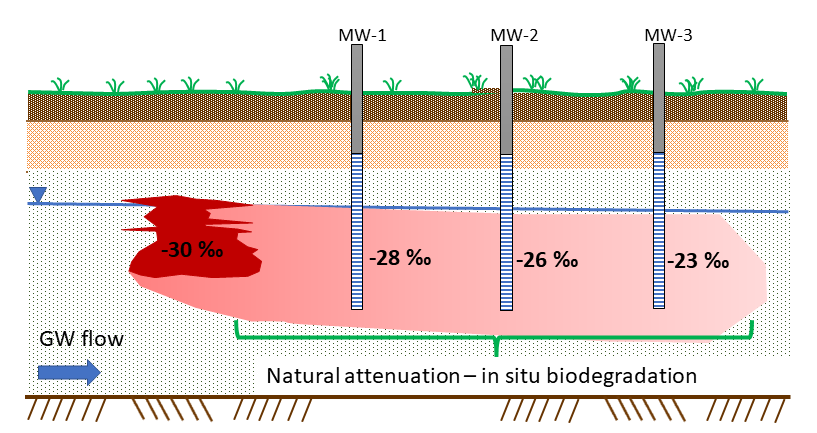 |
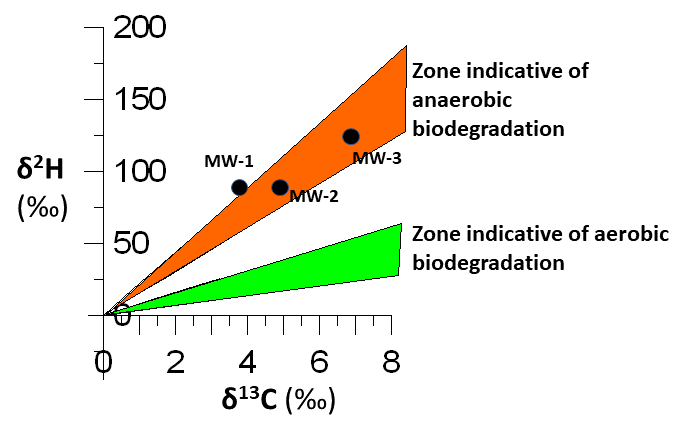 |
Beside biodegradation, recent studies have shown that positive and negative shifts in the δ13C, δ37Cl and δ2H values can be created by some physical and chemical removal processes induced by remediation treatments. According to the specific trend observed, a dominant physical or chemical removal process can thus be distinguished from another physical removal process or biological destruction of the compound.
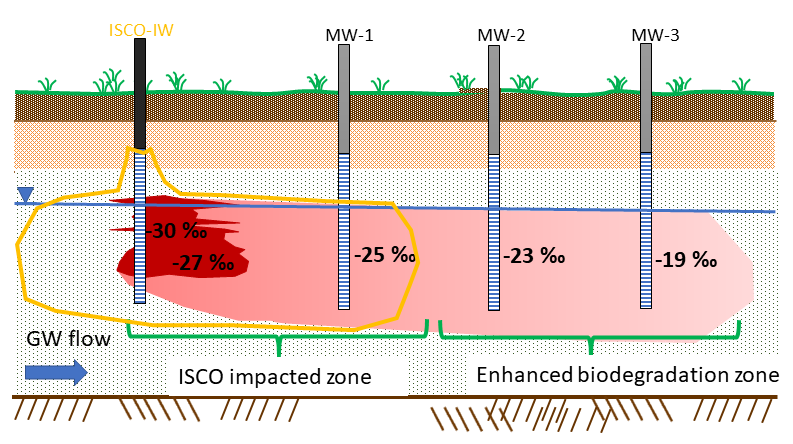 |
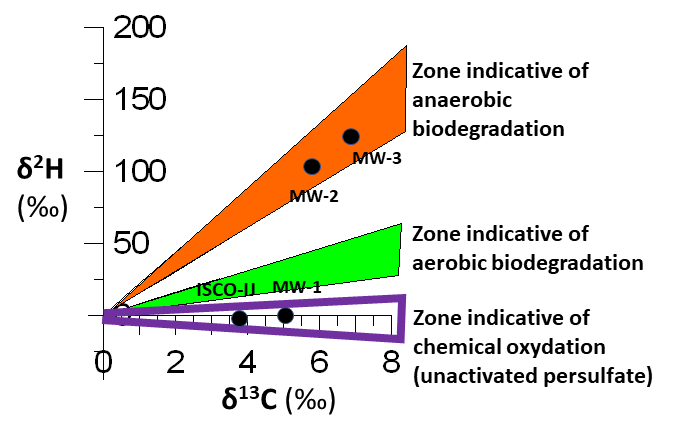 |
Whether you are at conducting pilot scale or large scale treatment, CSIA can be a valuable tool to validate if the intended mass removal process is actually initiated by the treatment. Here are some application suggestions for selected remediation treatments:
|
Remediation treatment |
Uncertainties addressed by CSIA |
|
Permeable reactive barrier |
|
|
ISCO treatment |
|
|
Air sparging \ SVE |
|
|
Bio-augmentation (chlorinated solvents) |
|
We our available to assist you in evaluating how CSIA can be strategically implemented to your site-specific remediation design.
CSIA advantages and limitations
The use of CSIA to assess performance of remediation treatment is quite recent and offers substantial advantages compared to traditional approaches:
- Gain of information on single compound
- Distinguish dilution from contaminant mass removal process. VOC concentration dilution due to fluid addition does not affect the δ13C and δ2H values
- Can be applied on site regardless of the treated zone (source or plume zone)
- Application simplicity: CSIA sampling procedure follows the SOP for VOC concentration analysis. The only need is to sample additional 40 ml glass vials.
- Deepen the knowledge gained during pilot scale efforts to further help dimensioning large scale treatment.
- The isotope shift over time validate remediation progress and/or success.
- Support remediation manager’s decision in whether the treatment needs timely adjustment.
Services offered
Our goal is to provide you the CSIA expertise you need to effectively implement CSIA on your site. Whether the assessment concern forensics, natural attenuation or remediation treatment performance, our Team can offer valuable support. These services include:
- Site data review to evaluate site-specific CSIA application, combined or not with other molecular tools (such as functional gene assays)
- Establishment of the assessment strategy
- Support with sampling requirements
- Data interpretation & reporting
- Discussion platform and recommendations
Suggested Publications to Learn More
Hunkeler D., Meckenstock, R.U., Lollar,B., Schmidt,T.C., Wilson, J.T.. A Guide for Assessing Biodegradation and Source Identification of Organic Groundwater Contaminants Using Compound Specific Isotope Analysis (CSIA). U.S. Environmental Protection Agency, Washington, D.C., EPA/600/R-08/148, 2009.
https://clu-in.org/download/contaminantfocus/vi/A%20Guide%20for%20Assessing%20Biodegradation.pdf
ITRC. Compound Specific Isotope Analysis. EMD Team Fact Sheet—November 2011
https://www.itrcweb.org/Documents/team_emd/CSIA_Fact_Sheet.pdf
Aelion, C.M., Höhener, P., Hunkeler, D., Aravena, R. Environmental Isotopes in Biodegradation and Bioremediation. 2009. CRC Press. 464 Pages, 1st Edition. ISBN 9781566706612.
Bouchard, D., Hunkeler, D., Madsen, E.L., Buscheck, T., Daniels, E., Kolhatkar, R., DeRito, C.M., Aravena, R., Thomson, N. Application of Diagnostic Tools to Evaluate Remediation Performance at Petroleum Hydrocarbon‐Impacted Sites. 2018. GWMR, vol 38, issue 4, 88-98.
